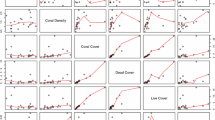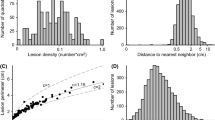Abstract
Acropora palmata is colonized by encrusting sponges, such as Clathria venosa, in the lower zones of coral branches, especially in areas devoid of living tissue. To analyze the responses of tissues involved in the areas of interaction, we investigated the advancement rates and the sponge growth and recovery rates after the removal of sponge tissue. To assess the advance or retreat rates of the sponge and coral, steel screws were placed at the limits of the sponge/coral interaction area (treatment 1), and the response of the coral and sponge tissues was recorded. In treatment 2, the sponge was removed by scraping and cleaning the area. In treatment 3, the sponge was removed, and the area occupied by the sponge was filled with epoxy putty. We found that the interaction was a standoff (T1) in 64.2% of cases, the sponge advanced in 7.1% of cases, and regression was observed in 28.7% of cases. Following its partial removal of the sponge (T2), C. venosa recovered the formerly occupied space in one month, whereas in T3, growth and recovery required 3 months. Clathria venosa is a colonizing species of the lower parts of the bases and branches of A. palmata, which despite presenting a rapid regeneration rate, no evidence was found that in contact with the coral, the sponge generates tissue deterioration.




Similar content being viewed by others
Data availability
Raw data that support the findings of this study are available from the corresponding author, upon reasonable request.
References
Aerts L (2000) Dynamics behind standoff interactions in three reef sponges species and the coral Montastraea cavernosa. Mar Ecol 21(3–4):191–204
Aerts LAM, Van Soest RWM (1997) Quantification of sponge/coral interactions in a physically stressed reef-community, NE Colombia. Mar Ecol Prog Ser 148:125–134
Alcolado PM (1984) New species of sponges from Cuba. Poeyana 271:1–22
Ayling A (1983) Growth and regeneration rates in thinly encrusting demospongiae from temperature waters. Biol Bull 165:343–352
Benzoni F, Calcinai B, Eisinger M, Klaus R (2008) Coral disease mimic: sponge attacks Porites lutea in Yemen. Coral Reefs 27:695
Busutil L, Alcolado PM (2012) Test of an urban organic pollution index based on Cuban reef sponge communities. Ser Oceanol 10:90–103
Carballo JL, Bautista E, Nava H, Crúz-Barraza JA, Chávez JA (2013) Boring sponges, an increasing threat for corals reefs affected by bleaching events. Ecol Evol 3(4):872–886
Chadwick NE, Morrow KM (2011) Competition among sessile organisms on coral reefs. In: Dubinski Z, Stambler N (eds) Coral reefs: an ecosystem in transition. Springer, New York, pp 324–350
Cháves-Fonnegra A, Zea S (2011) Coral colonization by the encrusting excavating Caribbean sponge Cliona delitrix. Mar Ecol 32:162–173
Cháves-Fonnegra A, López-Victoria M, Parra-Velandia F, Zea S (2005) Ecología química de las esponjas excavadoras Cliona aprica, C. caribbaea, C. delitrix y C. tenuis. Bol Inv Mar Cost 34:43–67
Cháves-Fonnegra A, Zea S (2007) Observations of reef coral undermining by the Caribbean excavating sponge Cliona delitrix (Desmospondiae, Hadromerida). In: Custódio MR, Lôbo-Hajdu G, Haidu E, Guilherme M (Eds) Porifera research: biodiversity, innovations and sustainability pp 247–254
Díaz J, Barrios L, Cendales M, Garzón-Ferreira J, Geister J, López-Victoria M, Ospina G, Parra-Velandia F, Pinzón J, Vargas-Angel B, Zapata F, Zea S (2000) Áreas coralinas de Colombia. Invemar Santa Marta. Ser Publ Espec 5:30–136
Engel S, Pawlik JR (2000) Allelopathic activities of sponge extracts. Mar Ecol Prog Ser 207:273–281
García-Urueña RP, Alvarado EM, Acosta A (1996) Crecimiento del coral Acropora palmata (Lamarck, 1886) en el Parque nacional natural corales del Rosario, Caribe Colombiano. Bol Inv Mar Cost 25:7–18
García-Urueña R, Garzón-Machado M, Sierra-Escrigas S (2020) Current assessment of the Acropora palmata and Acropora cervicornis populations in Tayrona national natural park, Colombian Caribbean. Bol Inv Mar Cost 49:137–166
González-Rivero M, Yakob L, Mumby PJ (2011) The role of sponge competition on coral reef alternative steady states. Ecol Mod 222:1847–1853
Halperin AA, Cháves-Fonnegra A, Gilliam DS (2016) Effects of excavating-sponge removal on coral growth. J Mar Biol Assoc 96:473–479
Hidaka M, Yamazato K (1984) Interspecific interactions in a scleractinian coral Galaxea fasicularis: induced formation of sweeper tentacles. Coral Reefs 3:77–85
Hoegh-Guldberg O, Poloczanska ES, Skirving W, Dove S (2017) Coral reef ecosystems under climate change and ocean acidification. Front Mar Sci 4:158. https://doi.org/10.3389/fmars.2017.00158
Kohler KE, Gill SM (2006) Coral Point Count with excel extensions (CPCe): a visual basic program for the determination of coral and substrate coverage using random point count methodology. Comput Geosci 32:1259–1269
Lages BG, Hovell Fleury BG, AM, Rezende CM, Pinto AC, Creed JC, (2012) Proximity to competitors changes secondary metabolites of non-indigenous cup corals, Tubastraea spp., in the southwest Atlantic. Mar Biol 159(7):1551–1559
Lapid ED, Wielgus J, Chadwick-Furman NE (2004) Sweeper tentacles of the brain coral Platygyra daedalea: induced development and effect on competitors. Mar Ecol Prog Ser 282:161–171
López-Victoria M, Zea S, Weil E (2006) Competition for space between encrusting excavating Caribbean sponges and other coral reef organisms. Mar Ecol Prog Ser 312:113–121
Martínez K, Rodríguez-Quintal JG (2012) Estructura poblacional de Acropora palmata (Scleractinia: Acroporidae) en el parque nacional San Esteban, Venezuela. Bol Inst Oceanogr Venezuela 51:129–137
McLean EL, Rützler K, Pooler PS (2015) Competing for space: factors that lead to sponge overgrowth when interacting with octocoral. J Mar Sci 5:64–80
Milne Edwards H, Haime J (1851) Recherches sur les polypiers. Mémoire 7. Monographie des Poritides. Ann Sci Nat, Zoologie, Series 3, 16:21–70
Nava H, Carballo JL (2013) Environmental factors shaping boring sponge assemblages at Mexican Pacific coral reefs. Mar Ecol 34(3):269–279. https://doi.org/10.1111/maec.12012
Pang RK (1973) The ecology of some Jamaican excavating sponges. Bull Mar Sci 23:227–243
Pineda-Munive EM, García-Urueña R, Zea S (2017) Acropora coral colonies as microhabitats for sponges in Tayrona national natural park, Colombian Caribbean. Mar Ecol 38:1–12
Quinn G, Keough M (2002) Experimental design and data analysis for biologists. Cambridge University Press, New York
Rossi G, Montori S, Cerrano C, Calcinai B (2015) The coral killing sponge Chalinula nematifera (Porifera: Haplosclerida) along the eastern coast of Sulawesi Island (Indonesia). Ital J Zool 81(1):143–148
Schneider CA, Rasband WS, Eliceri KW (2012) NIH Image to ImageJ: 25 years of image analysis. Nat Methods 9:671–675
Schönberg CHL (2002) Substrate effects on the bioeroding demosponge Cliona orientalis. 1 bioerosion rates. PSZN Mar Ecol 23:313–326
Schönberg CHL (2003) Substrate effects on the bioeroding Demosponge Cliona orientalis. 2. Substrate colonization and tissue growth. PSZN I: Mar Ecol 24:59–74
Schönberg CHL, Wilkinson CR (2001) Induced colonization of coral by a Clionid bioeroding sponge. Coral Reefs 20:69–76
Sebens KP (1986) Spatial relationships among encrusting marine organisms in the New England subtidal zone. Ecol Monogr 56(1):23–96
Turicchia E, Hoeksema B, Ponti M (2018) The coral-killing sponge Chalinula nemaifera as a common substrate generalist in Komodo national park, Indonesia. Mar Biol Res 14(8):827–833
Valderrama D, Zea S (2003) Esquemas de distribución de esponjas arrecifales (Porifera) del noroccidente del golfo de Urabá, Caribe Sur, Colombia. Bol Invest Mar Cost 32:37–56
Wulff JL (2006) Resistance vs recovery: morphological strategies of coral reef sponges. Funct Ecol 20:699–708
Wulff JL (2010) Regeneration of sponges in ecological context: is regeneration an integral part of life history and morphological strategies? Integr Comp Biol 50:494–505
Wulff JL (2012) Ecological interactions and the distribution, abundance, and diversity of sponges. Adv Mar Biol 61:273–344
Wulff JL (2016) Sponge contribution to the geology and biology of reefs: past, present, and future. In: Hubbard D, Rogers C, Lipps J, Stanley Jr G (eds) Coral reefs at the crossroads. Coral reefs of the world, vol 6. Springer, Dordrecht. https://doi.org/10.1007/978-94-017-7567-0_5
Zea S (2014) Taxonomy of Clathria (Thalysias) (Demospongiae: Poecilosclerida: Microcionidae) from the Colombian Caribbean, with description of three new species. Zootaxa 3835(4):401–436
Zea S, López-Victoria M, Weil E (2003) Impacto de esponjas excavadoras incrustantes en arrecifes del Caribe colombiano: mecanismos y efectos sobre la comunidad arrecifal de la Isla de San Andrés y las Islas del Rosario. Universidad Nacional de Colombia, Informe temático divulgativo, p 57
Zea S (1987) Esponjas del Caribe colombiano: Un catálogo sistemático y una guía de campo. Primera edición. Editorial Catálogo científico p 286
Acknowledgments
We thank the research group “Ecology and Diversity of Marine Algae and Coral Reefs” of the University of Magdalena in the Young Researcher-Colciencias period of the scholarship internship (Convocation 706 of 2015).
Funding
This work was funded by Colciencias as part of the project “Acropora: key genus for its conservation: genetic diversity, connectivity and ecological updates of their populations in the Colombian Caribbean” (111771451011).
Author information
Authors and Affiliations
Corresponding author
Ethics declarations
Conflict of interest
The authors declare that they have no conflict of interest.
Ethical approval
All applicable international, national, and institutional guidelines for the care and use of animals were followed.
Additional information
Handling Editor: Dr. Télesphore Sime-Ngando
Publisher's Note
Springer Nature remains neutral with regard to jurisdictional claims in published maps and institutional affiliations.
Rights and permissions
Springer Nature or its licensor holds exclusive rights to this article under a publishing agreement with the author(s) or other rightsholder(s); author self-archiving of the accepted manuscript version of this article is solely governed by the terms of such publishing agreement and applicable law.
About this article
Cite this article
Pineda-Munive, E.M., García-Urueña, R. Interaction between the thinly encrusting sponge Clathria venosa and the branched coral Acropora palmata. Aquat Ecol 56, 973–981 (2022). https://doi.org/10.1007/s10452-022-09981-7
Received:
Accepted:
Published:
Issue Date:
DOI: https://doi.org/10.1007/s10452-022-09981-7




